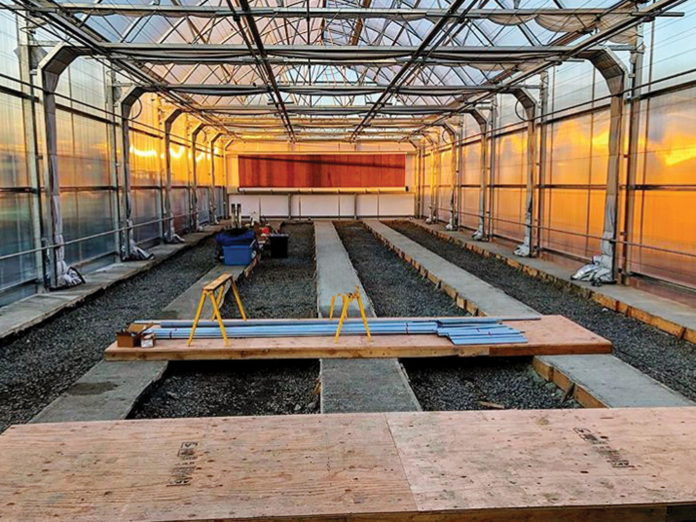Growers have a lot to worry about when looking for a new facility, most notably codes that inevitably will change during mid-construction. But, that’s a different article for a different day. For now, let’s talk about what you need to be prepared for and how to successfully leverage your knowledge to make your move into a new facility fruitful.
Know your limits and goals
One avenue to success falls under timing and space utilization. Find where you can make the best use of all your space, from horizontal to vertical. Vertical grows definitely are on the rise and, in Oregon at least, a space can be determined based on size and square footage of the canopy, not just square footage of the footprint. This means you easily can utilize vertical space. That said, it is important to consider even a simple change of venue can require a learning curve, and the systems of vertical growing will be no different.
It also is important, during your facility planning, to ensure you have a solid handle on the function and flow of your space. You should determine what your storage needs are, your comfortable work pathways, and the form and function of your systems. All of these will be critical in your design and build.
Do ‘sustainability’ the right way
Sustainability is one of the biggest buzzwords in any industry right now, and while this is a great step forward it also is important to ensure we are not using “sustainability” only as a marketing device. Being truly sustainable depends on a variety of factors up to and including what you value as sustainable. If energy efficiency is your priority, there are those who consider sunlight to be the only truly sustainable option. If you take a broader view incorporating environmental impact and ecological systems, then indoor growing could be more sustainable than traditional agricultural expectations. Sustainability also could be considered in how you utilize your workforce, how you engage your systems, and how efficiently you maintain and utilize your time.
Understanding and aligning your systems with your values is a crucial part of applying sustainability as an industry practice and standard. Part of engaging your systems is looking at how they integrate with each other. Are your systems well integrated? Are you utilizing every available part of the energy sources you engage? For example, if you’re trying to disperse large amounts of heat, is there a way to capture that heat and reuse it in the wintertime when you actually need it? Can you then use the heat from that to do other tasks, like heat your offices? All of these are systems related.
You also need to integrate temperature and humidity in a sustainable way, meaning they need to play well with each other. Do you have an HVAC system that considers both temperature and humidity in an integrated way? Are you factoring in your water usage?
As more growers—your competitors—become increasingly aware of how to use fewer resources, your ability to maintain a competitive place in the market will depend on the efficiency and sustainability of your practices. The reality of a highly competitive landscape is that buzzwords will not be enough. Go beyond that. It’s important for your bottom line.
Ask the hard questions up front
I have a mantra for new clients when they ask what they’ll need: “Water. Power. Water. Power. Water. Power.” This might seem elementary, but when choosing a building or facility you need to ensure there’s enough available power and water, whether that’s a rural property or in the middle of town. While these questions need to be answered for all types of properties, how they are framed will vary.
For example, you may need to determine whether a rural property has water rights or a commercial well with the capacity to pump the necessary amount of water at the correct pressure. Ensuring water is clean and safe is imperative for urban properties. If these things are not readily available, what will it take to acquire them? More importantly, what will acquisition cost? Many of us think having power simply means flipping on the lights. Usually, this is not the case. Power grids in rural communities are woefully unprepared for the cannabis industry. What will it take in both time and cost to get the power you need, and how does that impact your business planning?
Early on in legalization, the largest, most catastrophic mistake growers made was believing agricultural properties cost less, so they bought ag properties. It turned out upgrades cost them three times as much as obtaining a similar space in town. Get past the aesthetics of the property.
Don’t assume the industrial site you found will be any easier, either. What will it take to make a great industrial site meet the safety standards consumers expect? What other industrial businesses are nearby, and what is the environmental impact of their waste products? While the building may seem ideal, what pollution-mitigation costs might you have to consider?
Be aware but vigilant
Obviously, there are many variables, numerous questions, and more than a few different answers. No facility will be a precise fit “out of the box.” It’s not easy to set up a grow facility, but it’s not impossible either. Ask yourself the hard questions and find a reputable partner or contractor who knows the industry, its challenges, and solutions.
And keep your eye on the end game: a system that produces the maximum yield, high quality, and consistent crops your market demands.

Anya Gordon is the chief executive officer for GroTec Builders, a general contracting and development firm based in Portland, Ore.











